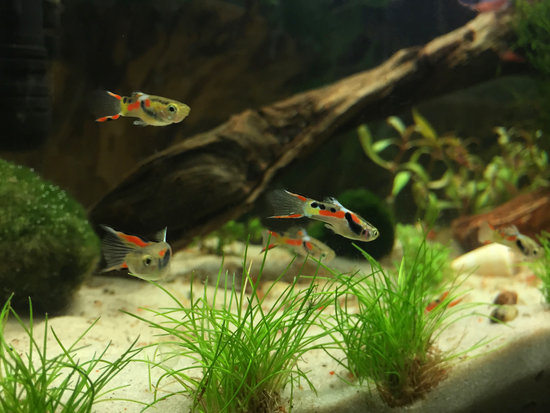
You will receive a sustainable, reproducing colony with approximately a 50/50 male to female ratio. We use a state of the art Hatchery that raise their Tilapia on a high protein Non-GMO diet to ensure they are a high quality fish that grow rapidly. Somehow, this ritual ends in her swimming into one of the fish condos sitting in the bottom of their tank and laying her eggs. Once he gets a good grip, he begins dragging her around the tank like an apache dancer, which sends the fish water flying all over the place. The larger one on the left, which is the male is placing his huge lips over the lips of the smaller one on the right, which is the female. You're shipment will contain about a 50/50 male to female ratio, and once they are of mating age, you'll witness this incredible mating dance. It is up to you to know your state's regulations as we ship to all states except Utah, Illinois, Hawaii and portions of Florida and if restricted, they may be confiscated upon arrival in your state. So before you order fish, you need to do some research to discover what your state’s or county’s Fish and Game Dept. Illinois requires a special permit, so we cannot ship to Utah, Illinois, Hawaii and portions of Florida. Both Blue Tilapia and Nile Tilapia, which are cold water resistant, are restricted in California. In California, Mossambicus Tilapia can be raised because they can’t survive in natural waterways during winter temperatures. However, some states don’t believe that is true and have labeled Tilapia an invasive species. Instead, because they consume plants and nutrients unused by other fish species and substantially reduce oxygen-depleting detritus, adding tilapia often increases the population, size and health of other fish.

Tilapia rarely compete with other "pond" fish for food. Tilapia consume floating aquatic plants, such as duckweed, water-meal, most "undesirable" submerged plants, and most forms of algae. Tilapia also serves as a natural biological control for most aquatic plant problems. Blue Tilapia are considered to be the tastiest as well as the hardiest Tilapia to raise. As a food fish, they are mild, tender and delicious and are becoming one of the most popular food fish on the market today. Tilapia can withstand all kinds of water quality issues including low pH, low oxygen levels, and high ammonia and nitrite levels.


 0 kommentar(er)
0 kommentar(er)
